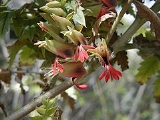
Melianthaceae
Encyclopedia
The Melianthaceae is a family
of flowering plant
s. The APG II system includes them within the rosid clade. All members of the Melianthaceae proper are tree
s or shrub
s found in tropical and southern Africa
. Francoaceae
(the Bridal wreaths) is sometimes included in the family, and consists of two monotypic genera found in Chile
.
is optionally included within the Melianthaceae.
Melianthaceae sensu stricto
Greyiaceae (included in Melianthaceae)
Francoaceae
(sometimes included, sometimes a separate family)
Family (biology)
In biological classification, family is* a taxonomic rank. Other well-known ranks are life, domain, kingdom, phylum, class, order, genus, and species, with family fitting between order and genus. As for the other well-known ranks, there is the option of an immediately lower rank, indicated by the...
of flowering plant
Flowering plant
The flowering plants , also known as Angiospermae or Magnoliophyta, are the most diverse group of land plants. Angiosperms are seed-producing plants like the gymnosperms and can be distinguished from the gymnosperms by a series of synapomorphies...
s. The APG II system includes them within the rosid clade. All members of the Melianthaceae proper are tree
Tree
A tree is a perennial woody plant. It is most often defined as a woody plant that has many secondary branches supported clear of the ground on a single main stem or trunk with clear apical dominance. A minimum height specification at maturity is cited by some authors, varying from 3 m to...
s or shrub
Shrub
A shrub or bush is distinguished from a tree by its multiple stems and shorter height, usually under 5–6 m tall. A large number of plants may become either shrubs or trees, depending on the growing conditions they experience...
s found in tropical and southern Africa
Africa
Africa is the world's second largest and second most populous continent, after Asia. At about 30.2 million km² including adjacent islands, it covers 6% of the Earth's total surface area and 20.4% of the total land area...
. Francoaceae
Francoaceae
The Francoaceae are a small family of plants, including the genus Francoa, commonly known as Bridal Wreaths. There are two genera, each with a single species....
(the Bridal wreaths) is sometimes included in the family, and consists of two monotypic genera found in Chile
Chile
Chile ,officially the Republic of Chile , is a country in South America occupying a long, narrow coastal strip between the Andes mountains to the east and the Pacific Ocean to the west. It borders Peru to the north, Bolivia to the northeast, Argentina to the east, and the Drake Passage in the far...
.
Classification
The family Greyiaceae is merged into the Melianthaceae in the APG II system; FrancoaceaeFrancoaceae
The Francoaceae are a small family of plants, including the genus Francoa, commonly known as Bridal Wreaths. There are two genera, each with a single species....
is optionally included within the Melianthaceae.
Melianthaceae sensu stricto
- BersamaBersamaBersama is a genus of small trees in family Melianthaceae. The genus is distributed across sub-Saharan Africa, and contains only two species:* Bersama abyssinica, Fresen.* Bersama swynnertonii, Baker f....
- 2 species - MelianthusMelianthusMelianthus is a genus of plants and shrubs native to South Africa, but much propagated in gardens world wide.-External links:*...
- 6 species
Greyiaceae (included in Melianthaceae)
- GreyiaGreyiaGreyia is a genus of plant in family Melianthaceae. It contains three species:* Greyia flanaganii, Bolus* Greyia radlkoferi* Greyia sutherlandii...
- three species
Francoaceae
Francoaceae
The Francoaceae are a small family of plants, including the genus Francoa, commonly known as Bridal Wreaths. There are two genera, each with a single species....
(sometimes included, sometimes a separate family)
- Francoa sonchifoliaFrancoaFrancoa is a genus of the Francoaceae family which consists of herbs endemic to Chile. Plants may grow up to one metre high and produce basal clumps of round, deeply lobed, dark green, fuzzy leaves with winged leafstalks...
- a single species - Tetilla hydrocotylefoliaTetillaTetilla is a genus of the Francoaceae family. It includes only the species Tetilla hydrocotylefolia, an herb endemic to Chile, commonly known as Bridal Wreath....
- a single species

